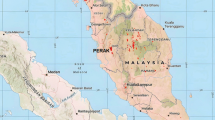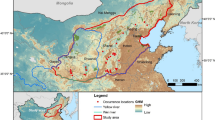Abstract
The present study aims to identify the potential habitat for swamp deer (Cervus duvauceli duvauceli Cuvier) in Jhilmil Jheel Conservation Reserve in the Uttarakhand province of India using multi-criteria analysis. The study area represents one of the last remnant habitats of the flagship species, the swamp deer in Uttarakhand, which is considered as vulnerable. The study showed that only 6.08% of the study area (225 km2) was highly suitable to suitable for the swamp deer. An area of 135.52 km2 (60.23%) turned out to be moderately suitable. Within the officially designated Conservation Reserve (area 37.84 km2), 10.91% (4.13 km2) area was found highly suitable to suitable, while 74.19% (28.07 km2) happens to be moderately suitable. Only 14 km2 area, which was found as suitable habitat for swamp deer falls short of the space required by a population of 134 animals. The problem could be mitigated if the agricultural land (2.47 km2) adjacent to the Jhilmil Jheel is brought under the Reserve management. This would provide additional area to meet the fodder requirement. The study brings out a particularly grim situation with limited options for conservation and management of the swamp deer in the Indo-Gangetic plains. It also emphasizes the role of geospatial techniques in quick appraisal of habitat attributes and identification of potential sites for protected areas.






Similar content being viewed by others
References
Alfred JRB, Kankane PL, Kumar A, Roy PS, Singh S, Verma M (2001) Habitat suitability analysis for chinkara, Gazella bennetti in Rajasthan: a remote sensing and GIS approach. ZSI Occasional Paper 189:1–73
Anonymous (1980) Habitat evaluation procedures (HEP). USDI Fish and Wildlife Service, ESM 102, Washington DC
Anonymous (1981) Standards for the development of habitat suitability index models for use in the habitat evaluation procedures. USDI Fish and Wildlife Service, Division of Ecological Science ESM 103, Washington DC
Anonymous (2005) Jhilmil Jheel Conservation Reserve. Forest Department, Government of Uttaranchal, Uttarakhand
Beier P, Majka DR, Spencer WD (2008) Forks in the road: choices in procedures for designing wildland linkages. Conservation Biology 22(4):836–851
Bright LR (1984) Assessment of elk habitat for resource management and planning activities from Landsat mapping products. In: Renewable Resources Management. American Society of Photogrammetry and Remote Sensing, Falls Church, Virginia, pp 101–108
Brown M, Lewis HG, Gunn SR (2000) Linear spectral mixture models and support vector machines for remote sensing. IEEE Transactions on Geosciences and Remote Sensing 38:2346–2360
Clark WR, Schmitz RA, Bogenshutz TR (1999) Site selection and nest success of ring-necked pheasants as a function of location in Iowa landscapes. Journal of Wildlife Management 63(3):976–989
George TH, Stringer WJ, Baldridge JN (1977) Reindeer range inventory in Western Alaska from computer-aided digital classification of Landsat data. In: Proceedings 11th International Symposium on Remote Sensing of Environment. Environmental Research Institute of Michigan (ERIM), Ann Arbor. pp 671–682
Giles RH (1978) Wildlife management techniques. Freeman and Co., San Francisco
Goswami A (2010) King Cobra Habitat monitoring and evaluation at Agumbe, Karnataka using geospatial techniques. P.G. Diploma dissertation, Indian Institute of Remote Sensing, Dehradun
Groves CP (1982) Geographic variation in the Barasingha or swamp deer (Cervus duvauceli). Journal of the Bombay Natural History Society 79:620–629
Habib B, Dar TA, Khan JA, Kushwaha SPS (2010) Evaluation of habitat suitability models for four sympatric ungulate species in Pathri Rao Watershed adopting geo-statistical modelling. Current Science 99(4):500–506
Hill GJE, Kelly GD (1987) Habitat mapping by Landsat for aerial census of kangaroos. Remote Sensing of Environment 21:52–60
Imam E, Kushwaha SPS, Singh A (2009) Evaluation of suitable tiger habitat in Chandoli National Park, India using multiple logistic regression. Ecological Modelling 220:3621–3629
Khanna V, Ravichandran MS, Kushwaha SPS (2001) Corridor analysis in Rajaji–Corbett Elephant Reserve—a remote sensing and GIS approach. Journal of the Indian Society of Remote Sensing 29(1):41–46
Kushwaha SPS, Hazarika R (2004) Assessment of habitat loss in Kameng and Sonitpur elephant reserves. Current Science 87(10):1447–1453
Kushwaha SPS, Roy PS (2002) Geospatial technology for wildlife habitat evaluation. Tropical Ecology 43(1):137–150
Kushwaha SPS, Roy PS, Azeem A, Boruah P, Lahan P (2000) Land area change and habitat suitability analysis in Kaziranga National Park, Assam. Tiger Paper 27(2):9–17
Kushwaha SPS, Munkhtuya S, Roy PS (2001) Geospatial modelling for goral habitat evaluation. Journal of the Indian Society of Remote Sensing 28(4):293–303
Kushwaha SPS, Khan A, Habib B, Quadri A, Singh A (2004) Evaluation of sambar and muntjak habitats using geostatistical modelling. Current Science 86(10):1390–1400
Lamprey HF (1963) Ecological separation of large mammal species in the Tarangire Game Reserve, Tanganyika. East African Wildlife Journal 5:151–166
Lillesand TM, Kiefer RW (2000) Remote sensing and image interpretation, 4th edn. Wiley, New York
Martin C (1977) Status and ecology of the Barasingha (Cervus duvauceli branderi) in Kanha National Park (India). Journal of the Bombay Natural History Society 74:60–132
Musavi A, Khan JA, Kumar S, Khan A, Mallik PK, Kushwaha SPS, Khati DVS, Sarin GD (2006) A study of tiger human conflict in buffer zone of the Corbett Tiger Reserve: protected area people relationship. International Journal of Ecology and Environmental Sciences 32(3):241–258
Nandy S, Kushwaha SPS, Mukhopadhyay S (2007) Monitoring the Chilla–Motichur wildlife corridor using geospatial tools. Journal for Nature Conservation 15:237–244
Nekhaya O, Arriazaa M, Guzmán-Álvarez JR (2009) Spatial analysis of the suitability of olive plantations for wildlife habitat restoration. Computers and Electronics in Agriculture 65(1):49–64
Panwar HS (1991) Status of management of protected areas in India: problems and prospects. Tiger Paper 18(3):17–25
Pocock R (1943) The larger deer of British India. Journal of the Bombay Natural History Society 43(4):553–572
Qureshi Q, Sawarkar VB, Mathur PK (1995) Ecology and management of swamp deer (Cervus duvauceli) in Dudhwa Tiger Reserve, U.P. (India). Project Report. Wildlife Institute of India, Dehradun
Saaty TL (1980) The analytic hierarchy process. McGraw-Hill, New York
Schaff D (1978) Population size and structure and habitat relations of the Barasingha (Cervus d. duvauceli) in Sukla Phanta Wildlife Reserve, Nepal. Ph.D. Dissertation, Michigan State University, USA
Schaller GB (1967) The deer and the tiger. Chicago University Press, Chicago
Schamberger M, Krohn WB (1982) Status of the habitat evaluation procedures. Transactions of the North American Wildlife and Natural Resources 47:154–164
Singh A, Kushwaha SPS (2011) Refining logistic regression models for wildlife habitat suitability modeling—a case study with muntjak and goral in the Central Himalayas, India. Ecological Modelling 222(8):1354–1366
Smith RL (1974) Ecology and field biology. Harper and Row, New York
Thomas RC, Kirby KJ, Reid CM (1979) The conservation of fragmented ecosystem within a cultural landscape-the case of ancient woodland in England. Biological Conservation 82:243–252
Zarri AA, Rahmani AR, Singh A, Kushwaha SPS (2008) Habitat suitability assessment for the endangered Nilgiri Laughingthrush: a multiple logistic regression approach. Current Science 94(11):1487–1494
Acknowledgments
The authors are thankful to Dr. P.S. Roy, Director, Indian Institute of Remote Sensing, Dehradun for encouragement and support for this study. Grateful thanks are due to the Forest Department, Government of Uttarakhand, Dehradun.
Author information
Authors and Affiliations
Corresponding author
Rights and permissions
About this article
Cite this article
Nandy, S., Kushwaha, S.P.S. & Gaur, P. Identification of Swamp Deer (Cervus duvauceli duvauceli Cuvier) Potential Habitat in Jhilmil Jheel Conservation Reserve, Uttarakhand, India Using Multi-Criteria Analysis. Environmental Management 49, 902–914 (2012). https://doi.org/10.1007/s00267-012-9826-5
Received:
Accepted:
Published:
Issue Date:
DOI: https://doi.org/10.1007/s00267-012-9826-5




